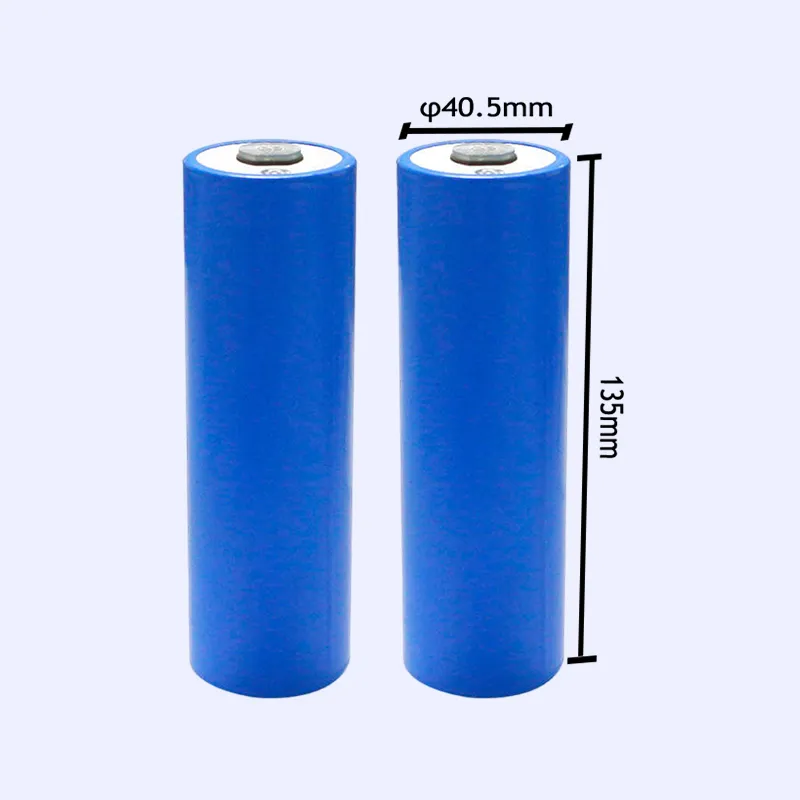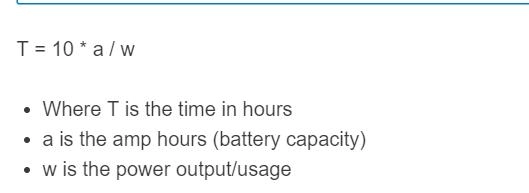Part 1. What is the Definition of Battery Life?
Battery life refers to the amount of time a battery can power a device before it needs to be recharged or replaced. It represents how long a device can run on a single battery charge.
For example, if a smartphone has a battery life of 10 hours, it means the device can run for 10 hours under normal usage conditions before needing to be recharged. Understanding battery life is crucial for managing device usage, especially when power sources are limited or unavailable.

Part 2. How to Calculate Battery Life Easily?
Calculating battery life is quite straightforward and involves using a simple formula that takes into account both the battery’s capacity and the device’s power consumption.
The formula for calculating battery life is as follows:
Battery Life (Hours) = Battery Capacity (mAh or Wh) / Device Power Consumption (mA or W)
Example:
If you have a 3000mAh battery and the device consumes 100mA, the runtime would be:
Runtime = 3000mAh / 100mA = 30 Hours
Calculation Steps:
- Determine Battery Capacity: First, identify the battery capacity, which is typically measured in milliampere-hours (mAh) or watt-hours (Wh). This information can typically be found on the battery or the device’s specifications.
- Determine Device Power Consumption: Next, identify the device’s power consumption, usually listed in watts (W) or milliamperes (mA). You may need to check the device’s user manual or specifications to find this value.
- Apply the Formula: Once you have both the battery capacity and device power consumption, you can easily calculate the battery life.
Part 3. Understanding the Battery Life Formula
The battery life formula is based on the relationship between amperes, watts, and volts. Here’s a breakdown of the key concepts:
- Ampere (A): Amperes measure the rate of electric current flow in a circuit, representing the amount of charge passing through a point in the circuit per unit of time. Formula:
I = Q / t
Where:
I = Current (in Amperes)
Q = Charge (in Coulombs)
t = Time (in Seconds) mAh (milliampere-hour) represents the product of current and time, and is commonly used to describe battery capacity. 1000mAh equals 1Ah (ampere-hour). - Volt (V): Volts represent the electric potential difference between two points in a circuit, essentially the force or pressure that drives the current. Formula:
V = W / Q
Where:
V = Voltage (in Volts)
W = Work (in Joules)
Q = Charge (in Coulombs) - Watt (W): Watts measure the rate of energy transfer or consumption in a circuit, showing the amount of work done per unit of time. Formula:
P = V * I
Where:
P = Power (in Watts)
V = Voltage (in Volts)
I = Current (in Amperes)
Part 4. Battery Life Calculation Examples
Let’s look at some real-world examples to better understand how to calculate battery life.
Example 1: Power Tool
- Battery Capacity: 4000mAh
- Device Power Consumption: 500mA
Battery Life (Hours) = Battery Capacity (mAh) / Device Power Consumption (mA)
= 4000mAh / 500mA = 8 Hours
In this example, a power tool with a 4000mAh battery and a power consumption of 500mA can run for approximately 8 hours on a single charge.
Example 2: Laptop
- Battery Capacity: 5000mAh
- Device Power Consumption: 1A (1000mA)
Battery Life (Hours) = Battery Capacity (mAh) / Device Power Consumption (mA)
= 5000mAh / 1000mA = 5 Hours
For a laptop with a 5000mAh battery and a power consumption of 1A (1000mA), the battery will last approximately 5 hours before needing to be recharged.
Example 3: Smartphone
- Battery Capacity: 3000mAh
- Device Power Consumption: 150mA
Battery Life (Hours) = Battery Capacity (mAh) / Device Power Consumption (mA)
= 3000mAh / 150mA = 20 Hours
For a smartphone with a 3000mAh battery and a power consumption of 150mA, the battery can last approximately 20 hours on a full charge.
Now that you understand how to calculate battery life, you can more easily estimate how long your devices can run before needing to be recharged. By considering both the battery’s capacity and the device’s power consumption, you can manage your devices more effectively, especially when you’re away from power sources. If you’re curious about the differences between 3.7V and 7.4V lithium batteries, it’s important to consider how voltage plays a role in overall battery performance for optimal performance.
Battery Runtime Calculation and Factors Affecting Battery Life
Example 1: Smartphone Battery
- Battery Capacity: 3000mAh (or 3Ah)
- Device Power Consumption: 200mA (or 0.2A)
- Battery Voltage: 3.7V (standard voltage for lithium-ion smartphone batteries)
Calculate the battery capacity (Watt Hours Wh):
Battery Capacity (Wh) = Battery Capacity (Ah) * Battery Voltage (V)
= 3Ah \* 3.7V
= 11.1Wh
Now, calculate the battery runtime:
Battery Runtime (Hours) = Battery Capacity (mAh) / Device Power Consumption (mA)
= 3000mAh / 200mA
= 15 Hours
Example 2: Flashlight
- Battery Capacity: 1000mAh (or 1Ah)
- Device Power Consumption: 50mA (or 0.05A)
To determine the battery capacity (Watt Hours Wh), assume the flashlight battery has a voltage of 1.5V:
Battery Capacity (Wh) = Battery Capacity (Ah) * Battery Voltage (V)
= 1Ah \* 1.5V
= 1.5Wh
Now, calculate the battery runtime:
Battery Runtime (Hours) = Battery Capacity (mAh) / Device Power Consumption (mA)
= 1000mAh / 50mA
= 20 Hours
These examples illustrate how to determine the battery runtime of various devices using different units and formulas.
Example 3: Solar Panel Battery
- Battery Capacity: 150Ah
- Device Power Consumption: 300W
Calculate the battery runtime for a solar panel system:
Battery Runtime (Hours) = (Battery Capacity (Ah) * Battery Voltage (V)) / Device Power Consumption (W)
= (150Ah * 12V) / 300W
= 6 Hours
This means the solar panel battery can run for approximately 6 hours when powering a 300W device. However, this calculation can vary based on factors such as the solar panel’s output and available sunlight. Note that this calculation assumes a specific battery voltage of 12V. For a more accurate runtime estimate, the battery voltage must be factored into the equation.
Factors Affecting Battery Runtime
Battery Capacity
The battery capacity, measured in milliampere-hours (mAh) or watt-hours (Wh), directly impacts how long a battery lasts. Higher capacity batteries generally offer longer runtimes compared to smaller ones.
Device Power Consumption
The power consumption of the device connected to the battery affects how quickly the battery drains. Devices with higher power consumption will deplete the battery faster, resulting in shorter runtimes.
Battery Age
As batteries age, their capacity decreases, leading to reduced runtimes. The number of charge cycles, exposure to extreme temperatures, and overall usage can contribute to battery degradation over time.
Temperature
Battery performance is sensitive to temperature, with extreme heat or cold affecting battery efficiency. It’s important to keep devices within the recommended temperature range to maintain optimal performance and preserve battery life.
Usage Habits
Intensive tasks like gaming or video streaming consume more power, decreasing battery life, while lighter tasks like browsing or reading require less power, extending runtime.
Screen Brightness and Connectivity
Settings such as screen brightness and active connectivity features (Wi-Fi, Bluetooth, GPS) can significantly impact power consumption. Higher screen brightness and actively using connectivity features will drain the battery faster, resulting in shorter runtimes.
Background Processes
Even when you’re not actively using apps, those running in the background can consume power. Closing unnecessary apps and minimizing background processes can help conserve battery life.
Battery Chemistry
Different battery chemistries, such as lithium-ion (Li-ion) or nickel-metal hydride (NiMH), have varying energy densities and discharge characteristics, which can affect battery runtime.
Conclusion
Now that you understand how to calculate battery runtime and the various factors that influence it, you can use our battery runtime estimation methods to estimate the performance of your devices.
FAQ
How can I estimate the runtime of a battery?
Estimating battery runtime requires considering both the battery’s capacity and the device’s power consumption. Refer to the examples and factors discussed earlier in this article for a more detailed explanation.

Appliance Battery Run Time
To calculate how long a 100Ah battery can power a 400W appliance, divide the battery capacity (100Ah) by the appliance’s power consumption (400W). The result is a theoretical maximum run time; actual run time may vary.
Solar Battery Run Time Calculation
To estimate the run time of a solar battery, divide the battery capacity by the power consumption of the connected devices. Don’t forget to consider factors such as the power generation of the solar panel and the available sunlight hours.
Inverter Battery Run Time
To determine how long a battery can power an inverter, divide the battery capacity by the power draw of the inverter and connected devices. When calculating, consider inverter efficiency losses and battery voltage.
Impact of Battery Type and Chemistry on Run Time
Different battery types, such as lithium-ion and nickel-metal hydride (NiMH) batteries, have varying chemistries and energy densities, which impact run time.
Temperature and Battery Performance
Extreme temperatures, whether high or low, can reduce battery capacity and efficiency, thereby reducing run time. To ensure optimal performance, devices should be used within the manufacturer’s specified operating temperature range.







